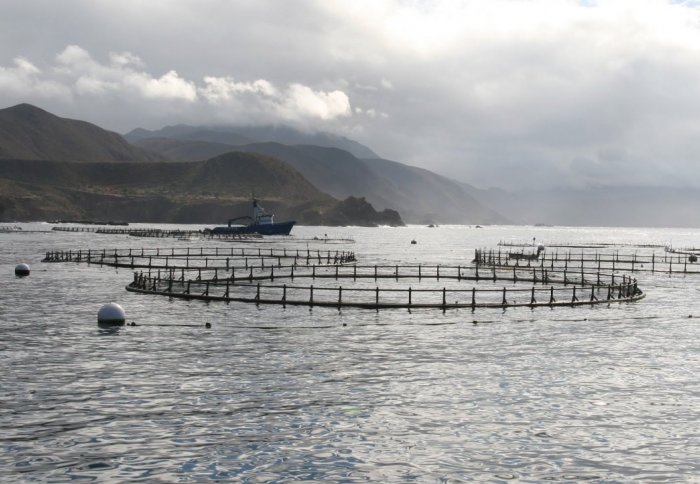Sustainable fish farming is possible for the majority of coastal countries

Fish farm. Credit: NOAA
Nearly every coastal country in the world has the potential to meet its own domestic seafood needs through aquaculture, suggests a new study.
Aquaculture is the farming of freshwater and saltwater aquatic organisms, including fish, crustaceans and molluscs such as oysters and mussels. The practice is the fastest-growing food sector, and it is hoped that aquaculture could help address increasing issues of food insecurity around the globe.
It’s not a question of if aquaculture will be part of future food production but, instead, where and when. Our results help guide that trajectory.
– Dr Ben Halpern
New research now reveals that most coastal countries could meet their own domestic seafood needs using a tiny fraction of their ocean territory, demonstrating the oceans’ potential to support aquaculture.
The study, led by scientists from UC Santa Barbara (UCSB) and including researchers from Imperial College London, the Nature Conservancy, UCLA and the National Oceanic and Atmospheric Administration, is published today in the journal Nature Ecology and Evolution.
Co-author Professor Ben Halpern, Chair in Marine Conservation at Imperial and executive director of the UCSB-affiliated National Center for Ecological Analysis and Synthesis (NCEAS), said: “Marine aquaculture provides a means and an opportunity to support both human livelihoods and economic growth, in addition to providing food security. It’s not a question of if aquaculture will be part of future food production but, instead, where and when. Our results help guide that trajectory.”
According to the study, the world’s oceans are rife with aquaculture ‘hot spots’, such as Indonesia, Kenya and Fiji, which provide enough space to produce 15 billion metric tons of fish annually. That is more than 100 times the current global seafood consumption.

Areas with aquaculture potential (blue) and aquaculture 'hotspots' (red). Kenya, Indonesia and Fiji are in boxes
More realistically, the researchers note, if aquaculture were developed in only the most productive areas, the oceans could theoretically produce the same amount of seafood that the world’s wild-caught fisheries currently produce globally, but in less than one per cent of the total ocean surface.
Untapped potential
Lead author Dr Rebecca Gentry, from UCSB’s Bren School of Environmental Science & Management, said: “There are only a couple of countries that are producing the vast majority of what’s being produced right now in the oceans. We show that aquaculture could actually be spread a lot more across the world, and every coastal country has this opportunity.”
While countries like Norway and China are producing a lot of aquaculture fish and bivalves, the United States, for example, has enormous untapped potential. The study shows that the US could produce enough farmed seafood to meet national demand using only 0.01 per cent of its exclusive economic zone.

To determine aquaculture’s global potential, the researchers identified areas where ocean conditions are suitable enough to support farms. They used synthesized data on oceanographic parameters like ocean depth and temperature and the biological needs of 180 species of finfish and bivalve molluscs, such as oysters and mussels.
The research team ruled out places that would come into conflict with other human uses, such as high shipping zones and marine protected areas, and excluded ocean depths that exceed 200 metres, following current industry practice to keep their assessment economically realistic. Their analysis did not consider all possible political or social constraints that may limit production.
An opportunity for future food
Dr Gentry said: “There’s so much area available that there’s a lot of flexibility to think about how to do this in the best way for conservation, economic development and other uses.”
The team emphasized that it will be crucial for science, conservation, policy and industry to work together to proactively ensure fish farms are not just well placed but also well managed, such as balancing nutrient inputs and outputs to avoid pollution and monitoring for diseases.
Co-author Dr Halley Froehlich, from NCEAS, said that ventures like fish aquaculture can fail unless properly managed, such as the boom and bust of US shrimp farming in the 1990s. She said: “Like any food system, aquaculture can be done poorly; we’ve seen it. This is really an opportunity to shape the future of food for the betterment of people and the environment.”
This research is part of the Science for Nature and People Partnership, a collaboration of NCEAS, The Nature Conservancy and the Wildlife Conservation Society.
-
'Mapping the global potential for marine aquaculture' by Rebecca R. Gentry, Halley E. Froehlich , Dietmar Grimm, Peter Kareiva, Michael Parke, Michael Rust, Steven D. Gaines and Benjamin S. Halpern is published in Nature Ecology and Evolution.
Article text (excluding photos or graphics) © Imperial College London.
Photos and graphics subject to third party copyright used with permission or © Imperial College London.
Reporter
Hayley Dunning
Communications Division